Why this resume works
- Quantifies accomplishments: Including measurable accomplishments like reducing damage incidents by 15% and improving packing efficiency by 20% clearly illustrates the applicant’s impact and value.
- Uses action-oriented language: Using action verbs such as “coordinated” and “streamlined” in job descriptions emphasizes the applicant’s initiative and effectiveness.
- Highlights industry-specific skills: Skills like inventory management and logistics coordination highlight industry-specific experience, showing the applicant’s fit for supply chain roles.
More Warehouse Associate Resume Examples
Check out our warehouse associate resume examples to understand how to highlight your organizational skills, inventory management experience, and teamwork. These inventory management resume samples will help you craft a resume that attracts employers in logistics and distribution.
Entry-Level Warehouse Associate
Why this resume works
- Effective use of keywords: Strategically weaving in role-relevant keywords, the applicant ensures their resume is optimized for applicant tracking systems (ATS), focusing on inventory control and supply chain optimization.
- Shows digital literacy: Skill in warehouse management software and inventory systems showcases computer skills and digital readiness for modern workplaces.
- Centers on academic background: Featuring degrees in business administration and logistics in the education section supports a strong academic foundation early in the career, improving credibility and potential.
Mid-Level Warehouse Associate
Why this resume works
- Points to measurable outcomes: By highlighting accomplishments like reducing waste and improving shipment efficiency, the applicant showcases impactful contributions and a focus on measurable outcomes in logistics roles.
- Includes a mix of soft and hard skills: Combining technical skills like forklift operation with interpersonal skills through team training highlights a balanced approach to workplace effectiveness.
- Demonstrates language abilities: Language skills in Spanish and French improve cross-cultural communication and support international logistics efforts.
Experienced Warehouse Associate
Why this resume works
- Lists relevant certifications: Through certifications like Certified Supply Chain Professional, the applicant showcases expertise and commitment to learning.
- Showcases impressive accomplishments: Managing a project that cut processing time by 15% reflects impactful achievements, emphasizing senior-level performance.
- Sections are well-organized: Strategic use of bullet points and headers creates an organized layout, making the resume easy to scan and reader-friendly.
Warehouse Associate Resume Template (Text Version)
John Anderson
Crestwood, KY 40014
(555)555-5555
John.Anderson@example.com
Professional Summary
Detail-oriented Warehouse Associate with extensive experience in logistics, known for improving inventory management efficiency by 30% using innovative systems and leading teams to exceed productivity targets.
Work History
Warehouse Associate
Efficient Operations Corp – Crestwood, KY
July 2024 – July 2025
- Managed inventory worth over 0K
- Reduced damage incidents by 15%
- Improved packing efficiency by 20%
Logistics Assistant
Precision Logistics – Crestwood, KY
June 2022 – June 2024
- Coordinated deliveries, increasing on-time rate by 25%
- Ensured 100% accuracy in shipment scheduling
- Streamlined operations, reducing costs by 12%
Order Fulfillment Clerk
Global Goods Distribution – Crestwood, KY
July 2021 – May 2022
- Processed 200 orders per week efficiently
- Enhanced inventory tracking accuracy by 10%
- Implemented safety protocols improving compliance
Skills
- Inventory Management
- Order Fulfillment
- Logistics Coordination
- Supply Chain Optimization
- Safety Protocols
- Team Collaboration
- Time Management
- Problem Solving
Certifications
- Certified Warehouse Professional – National Logistics Association
- OSHA Safety Certification – Occupational Safety & Health Administration
Education
Bachelor’s Degree Business Administration
California State University Los Angeles, CA
May 2021
High School Diploma
Los Angeles High School Los Angeles, CA
May 2017
Languages
- Spanish – Beginner (A1)
- French – Beginner (A1)
- Mandarin – Intermediate (B1)
Related Resume Guides
Advice for Writing Your Warehouse Associate Resume
Dive into our advice section on how to write a resume tailored to a warehouse associate position. Discover tips that highlight your skills in logistics, teamwork, and efficiency, making you shine in the bustling world of warehousing.
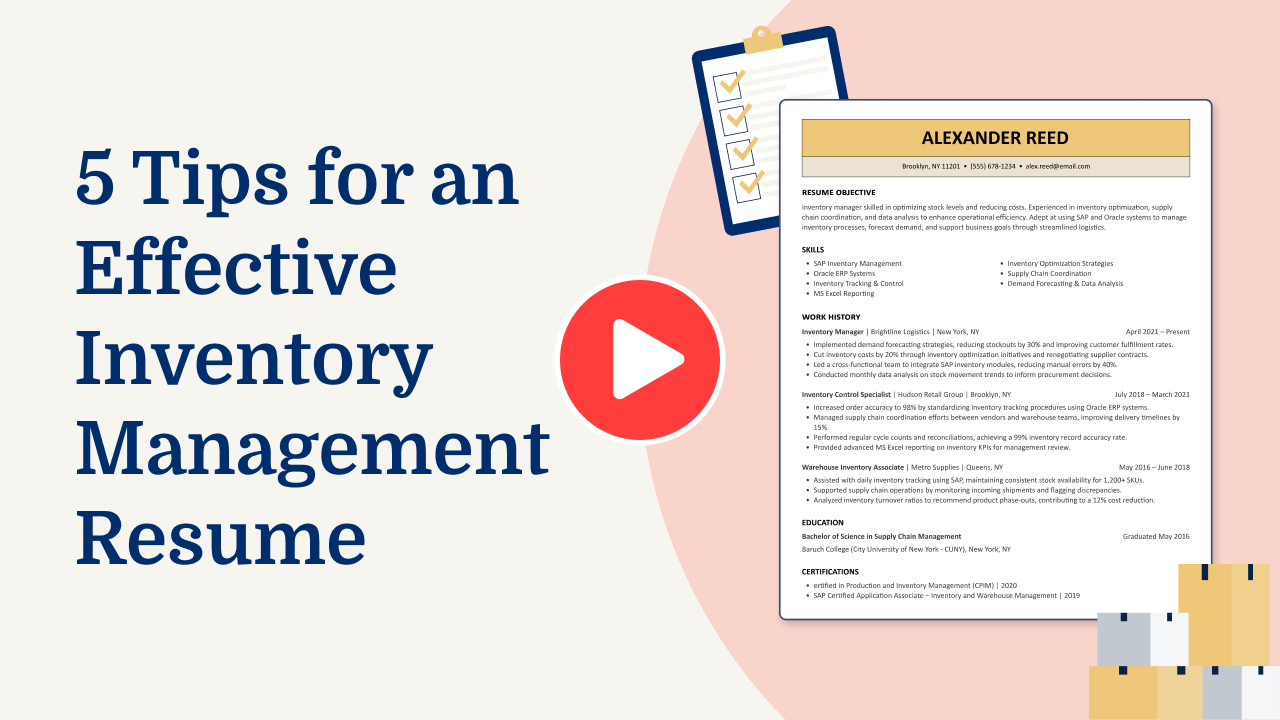
Highlight relevant technical skills
Technical skills are key for a warehouse associate. They help you do your job well and keep things running smoothly. You should have skills like operating forklifts, using warehouse management systems, and handling inventory software.
These tools let you move items safely and track them accurately. Knowing how to use barcode scanners and labeling equipment is also helpful because it speeds up sorting and shipping tasks.
When you make your resume, consider listing these technical skills in a dedicated skills section and include them in your work experience section. Describe how you’ve applied these skills on the job to improve processes or solve problems. For example, mention any time you helped reduce errors or improved efficiency by using specific equipment or software.
Common technical skills for this role might include computer literacy, especially in Microsoft Excel and data entry programs. Being familiar with logistics software can boost your ability to manage shipments effectively. Don’t forget safety practices like knowing how to handle hazardous materials properly—this shows you’re careful and follow rules while working in the warehouse environment.
Example of a technical skills section
- Inventory management systems (WMS, SAP)
- Barcode scanning and RFID technology
- Forklift operation and safety protocols
- Pallet jack usage
- Order picking and packing techniques
- Shipping and receiving procedures
- Basic Microsoft Excel for inventory tracking
- OSHA safety standards compliance
Build a standout resume in minutes with our easy-to-use Resume Builder. Choose a professional template, add your details, and make a strong impression on employers.
Quantify your accomplishments
Quantifying accomplishments in your resume makes it stand out by showing the actual impact of your work instead of just listing tasks. For a warehouse associate, turning responsibilities into measurable achievements highlights your value to employers.
Instead of saying “organized inventory,” you could write “managed inventory for 10,000+ items, reducing item retrieval time by 25%.” Numbers like percentages, cost savings, or efficiency gains help hiring managers quickly see how you’ve contributed to previous workplaces.
Each entry in the work experience section should include your job title, employer name, location, and employment dates. After that, focus on achievements tied to measurable results.
For example, rather than stating “packed orders,” say something like “processed and packed 150+ orders daily with zero errors.” Using action verbs like “improved,” “streamlined,” or “increased” paired with metrics creates a stronger impression and shifts attention from duties to results.
When hiring managers scan resumes, they look for evidence of skills and impact. Quantified accomplishments make it easy for them to assess how well you performed in past roles.
This approach shows you’re results-driven and able to make tangible improvements in areas such as productivity or accuracy—qualities that are critical for warehouse operations.
5 warehouse associate work history bullet points
- Processed and fulfilled an average of 200 orders daily, ensuring timely and accurate shipments that contributed to a 15% increase in customer satisfaction.
- Implemented a new inventory tracking system that improved stock accuracy by 20%, reducing lost sales due to out-of-stock items.
- Trained and mentored a team of 5 new warehouse associates, increasing overall team efficiency by 25%.
- Streamlined the receiving process, reducing unloading times by 30% and improving workflow efficiency across the warehouse.
- Conducted regular safety audits, leading to a 40% decrease in workplace accidents over one year.
Need help with your resume? Look at these professional resume examples to find styles that work and make your own stand out.
Write a powerful professional summary
A professional summary on a resume serves as an introduction for hiring managers, providing a snapshot of your skills and accomplishments. You can decide whether to use a summary or a resume objective based on your experience level and career goals.
A professional summary is a short paragraph that talks about your experience, skills, and achievements. It’s best for people who have worked before and want to show their professional identity and value. It tells employers what you’ve done and why you’re great for the job.
On the other hand, a resume objective is more about what you want to do. It’s good for people starting, changing careers, or who have gaps in their work history. While a summary says “what I’ve accomplished,” an objective says “what I aim to contribute.”
Next up, we’ll look at examples of both summaries and objectives for different jobs and levels of experience, including roles like warehouse associate.
Warehouse associate resume summary examples
Entry-level
Recent graduate with a Bachelor of Science in logistics and supply chain management, eager to apply academic knowledge to a warehouse associate role. Completed internships focused on inventory management and material handling. Certified in forklift operation and skilled in basic data entry tasks. Enthusiastic about learning and contributing to efficient warehouse operations.
Mid-career
Warehouse associate with over six years of experience specializing in inventory control and shipping coordination. Proven track record of optimizing storage solutions and reducing order processing times. Certified in hazardous materials handling, known for attention to detail and effective teamwork skills in high-volume environments.
Experienced
Senior warehouse associate with 12+ years of experience leading teams in fast-paced distribution centers. Expert in implementing lean practices that improve operational efficiency and reduce waste. Certified trainer for new hires, adept at managing complex logistics projects while ensuring safety standards are met. Committed to driving performance improvements across all warehouse functions.
Warehouse associate resume objective examples
Entry-level
Detail-oriented individual eager to begin a career as a warehouse associate, using strong organizational skills and attention to detail to contribute to efficient inventory management. Excited to support team operations in maintaining accurate stock levels and ensuring timely order fulfillment.
Career changer
Former retail professional transitioning into the role of warehouse associate, bringing experience in customer service and logistics coordination. Keen on applying problem-solving abilities and teamwork skills to improve warehouse processes and improve overall operational efficiency.
Recent graduate
Energetic recent graduate with a background in supply chain management seeking an entry-level position as a warehouse associate. Committed to applying academic knowledge and technical skills in a fast-paced environment, while contributing positively to inventory control and distribution efforts.
Use a polished and professional resume format that aligns with your experience level to ensure your skills and qualifications stand out to hiring managers.
Showcase your credentials
Listing certifications and specialized training for a warehouse associate is important because it shows skills and knowledge that go beyond basic job duties.
Having credentials can make you stand out to employers who want workers with proven abilities. Certifications often mean you’ve learned specific skills or safety practices needed to do the job well, like handling machinery or managing inventory systems. Here are a few examples for your resume:
- Certified Forklift Operator
- OSHA Safety Certificate
- Hazardous Materials Handling Certification
- Supply Chain Management Certificate
- Inventory Management Specialist
By creating a dedicated certifications section on your resume, you highlight your readiness and extra qualifications for the role. It complements your education section by showing hands-on expertise and commitment to learning more about the field. These credentials help demonstrate your ability to handle various tasks safely and efficiently in a warehouse setting.
Example of a certifications section
Forklift Operator Certification
Issued by: Occupational Safety and Health Administration (OSHA)
Issued 2023
Certified Logistics Associate (CLA)
Issued by: Manufacturing Skill Standards Council (MSSC)
Expires 2025
Hazardous Materials Handling Certification
Issued by: National Safety Council (NSC)
Issued 2021
Warehouse Management System Skill
Issued by: Supply Chain Industry Association
Expires 2024
Select a resume template that’s straightforward and professional. Opt for simple fonts and bold headings to ensure readability, avoiding elaborate designs that might overshadow your skills.
FAQ
Do I need to include a cover letter with my warehouse associate resume?
Yes, including a cover letter with your warehouse associate resume can make a positive impression on potential employers.
A cover letter lets you highlight your specific skills and experiences that match the job description, emphasizing qualities like attention to detail or teamwork.
For instance, if the warehouse uses particular inventory management systems or has unique operational needs, mentioning your experience in these areas could set you apart.
Consider using tools like our Cover Letter Generator to craft a personalized letter that complements your resume and shows key competencies relevant to warehousing.
Additionally, reviewing cover letter examples tailored for similar roles can inspire and ensure you’re effectively communicating your strengths.
How long should a warehouse associate’s resume be?
As a warehouse associate, a one-page resume usually does the job in highlighting your key skills and experience. Make sure to focus on physical stamina, inventory management systems knowledge, and efficient use of warehouse equipment.
If you have extensive experience or special certifications, stretching it to a two-page resume is fine, as long as it’s all relevant. Emphasize roles showing reliability and teamwork within warehouse operations.
Check out our guide on how long a resume should be for more tips tailored to your career stage.
How do you write a warehouse associate resume with no experience?
When you’re starting with no experience, your warehouse associate resume should showcase your skills, education, and any experiences that show potential for the role. Here are a few tips:
- Emphasize transferable skills: Warehouse roles often require skills like attention to detail, physical stamina, teamwork, and time management. Highlighting these can show employers you’re up for the job.
- Leverage volunteer or informal work experience: If you’ve ever helped with a move, organized an event, or participated in community service that involved logistics or physical labor, mention those experiences.
- Focus on education and training: If you’ve taken courses related to logistics or received certifications in areas like forklift operation or safety procedures, make sure these are prominently featured.
- Include a strong objective statement: Clearly express your enthusiasm for the warehouse industry and willingness to learn. This initial section can set a positive tone for your application.
See how to write a resume with no experience for detailed guidance on creating effective resumes for entry-level roles.
Rate this article
Warehouse Associate
Additional Resources
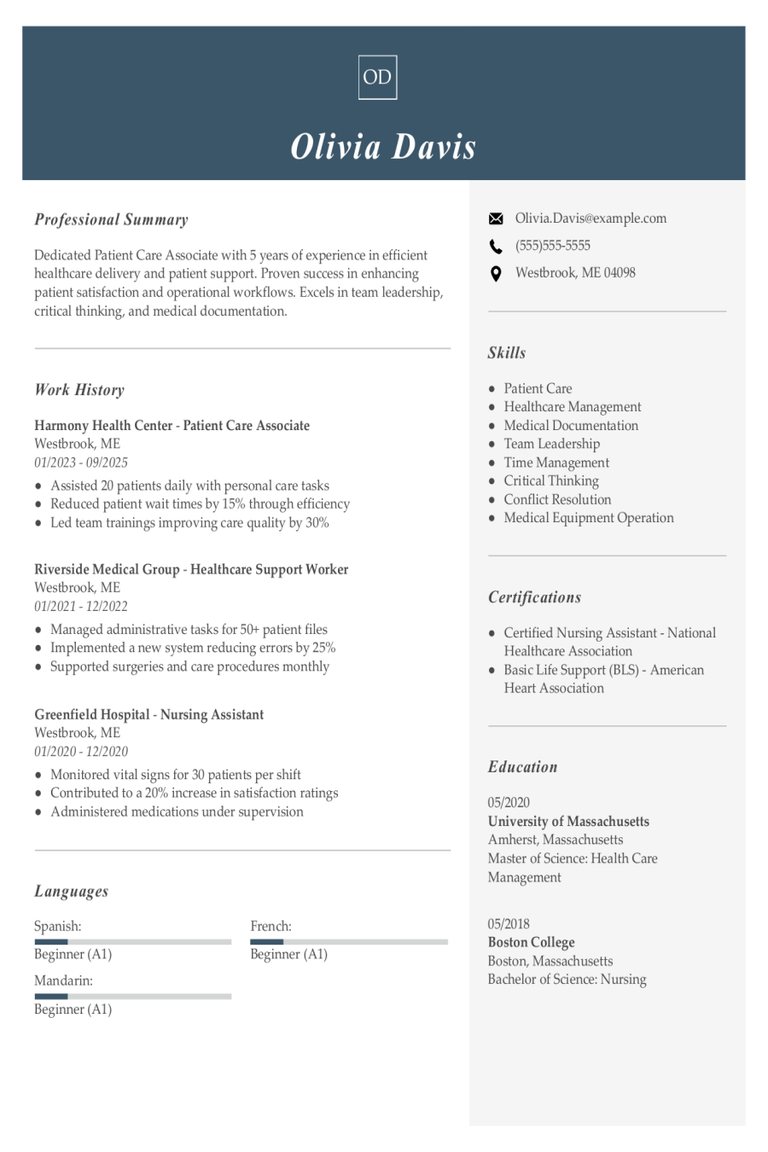
Patient Care Associate Resume Examples & Templates for 2025
Explore how patient care associates can showcase their skills in helping patients and supporting medical staff. Use these examples and tips to highlight your caring nature, teamwork abilities, and experience
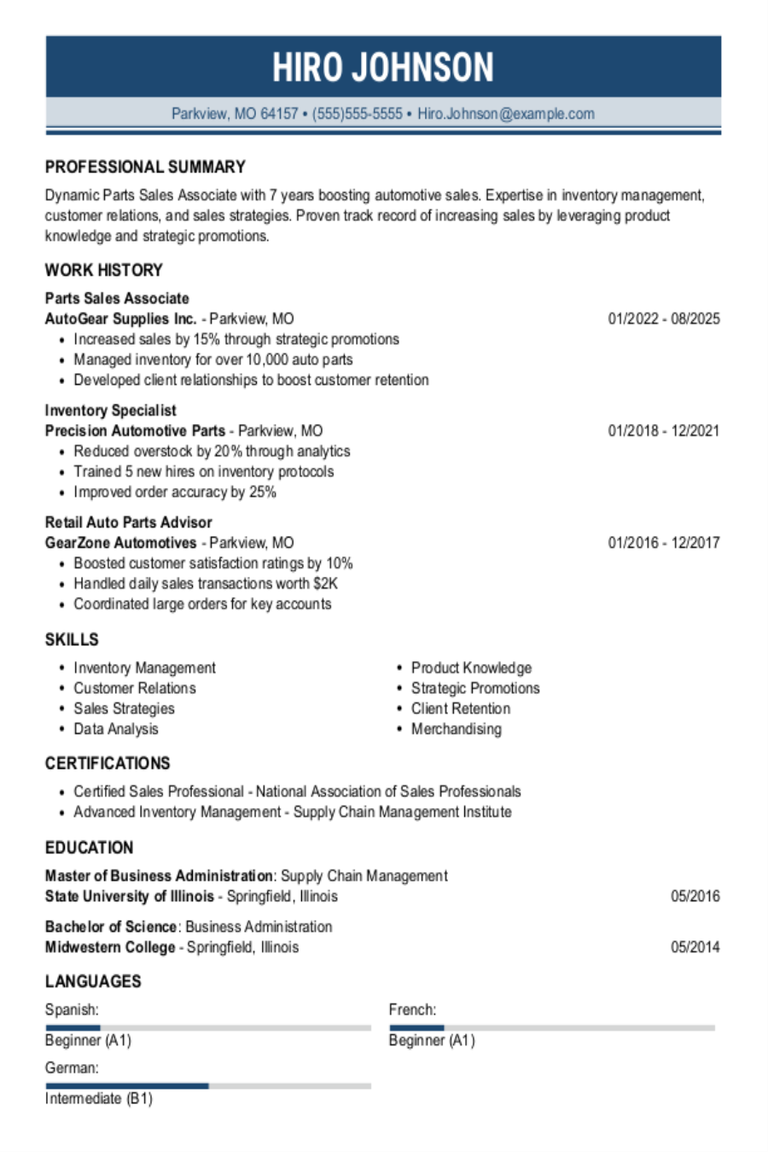
Parts Sales Associate Resume Examples & Templates for 2025
Explore parts sales associate resume examples that focus on customer service, product knowledge, and inventory management. Browse tips on how to show employers you’re helpful, knowledgeable, and ready to support
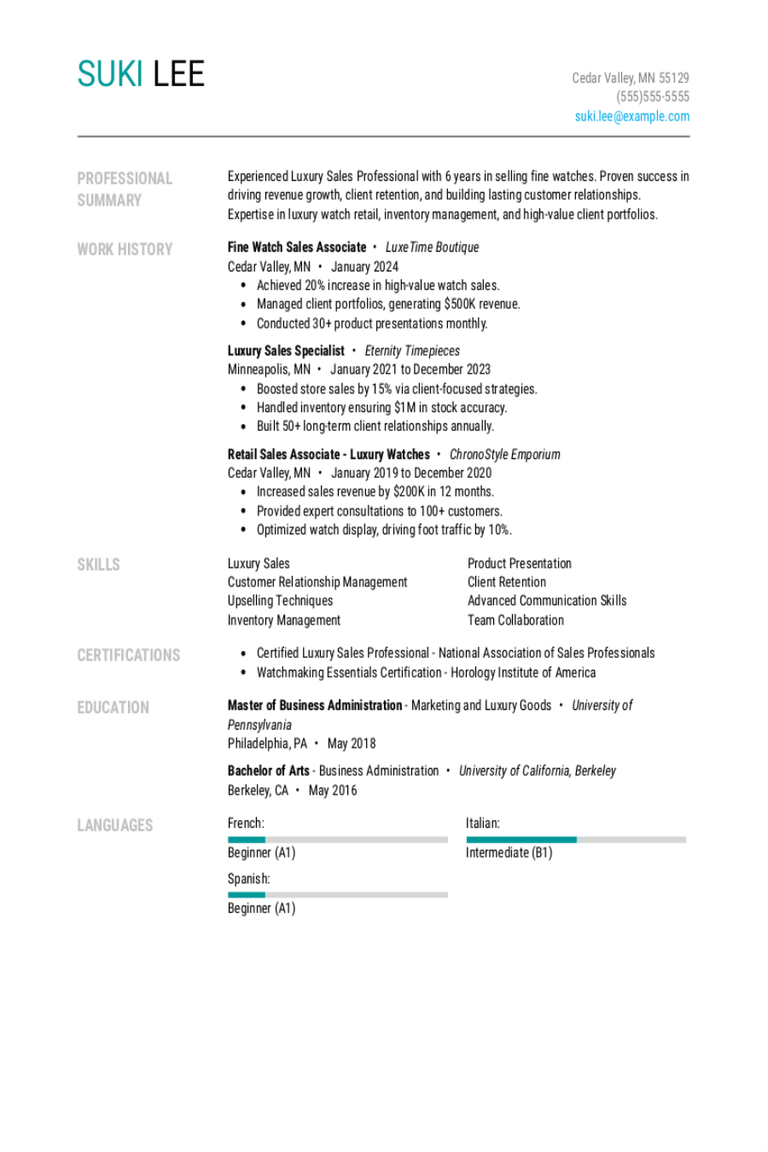
Fine Watch Sales Associate Resume Examples & Templates for 2025
Explore fine watch sales associate resume examples and tips to learn how to highlight your expertise in luxury timepieces, proven sales achievements, and exceptional client service skills to stand out
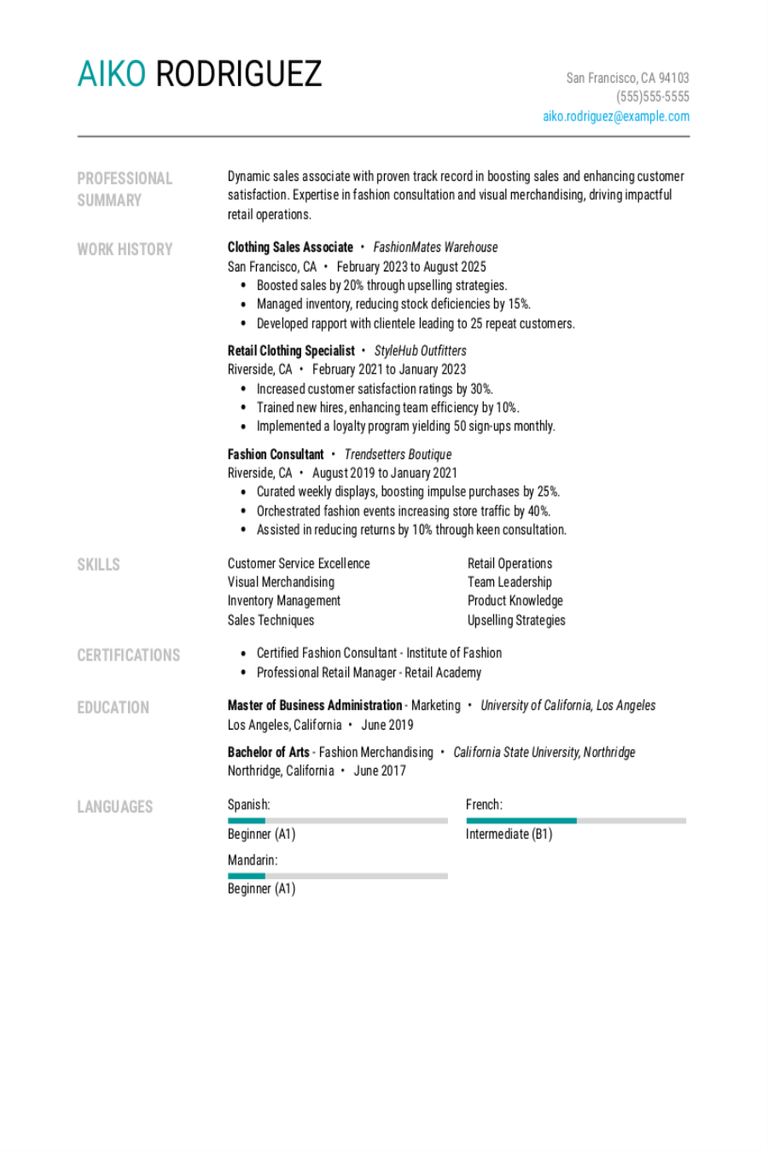
Clothing Sales Associate Resume Examples & Templates for 2025
Discover how clothing sales associates can showcase their knack for helping customers find the perfect outfit. These resume examples and tips will guide you in highlighting your style sense and
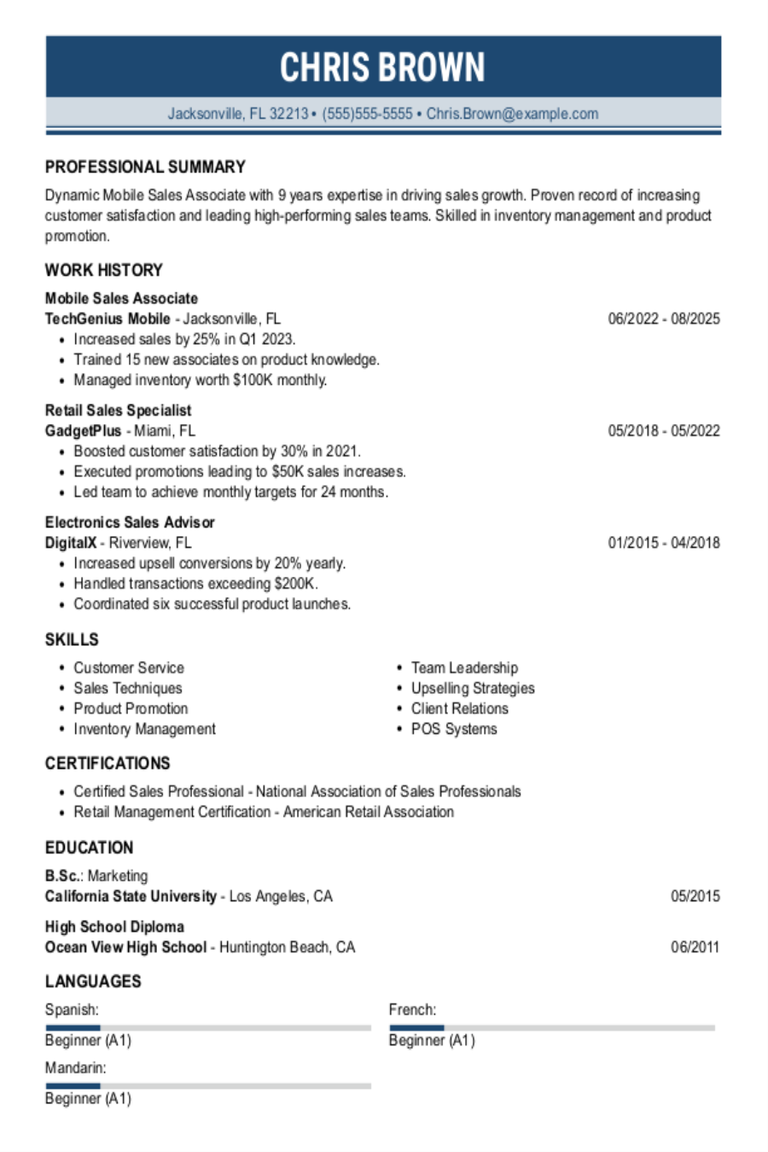
Mobile Sales Associate Resume Examples & Templates for 2025
As a mobile sales associate, your resume must show how you help customers, sell phones, and manage inventory. Use our examples as a guide to help you highlight your fit
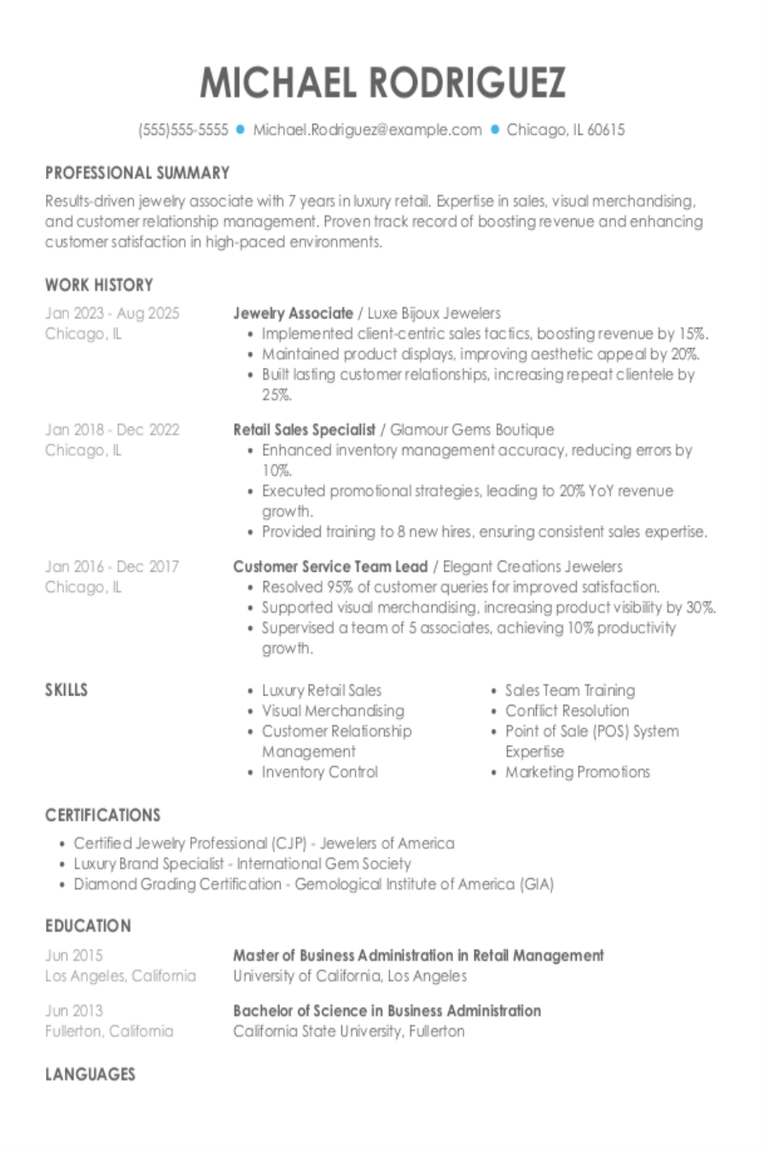
Jewelry Associate Resume Examples & Templates for 2025
Discover jewelry associate resume examples that show you how to showcase your skills. Learn how to show off customer service abilities and sales experience to catch an employer’s eye.Build my
